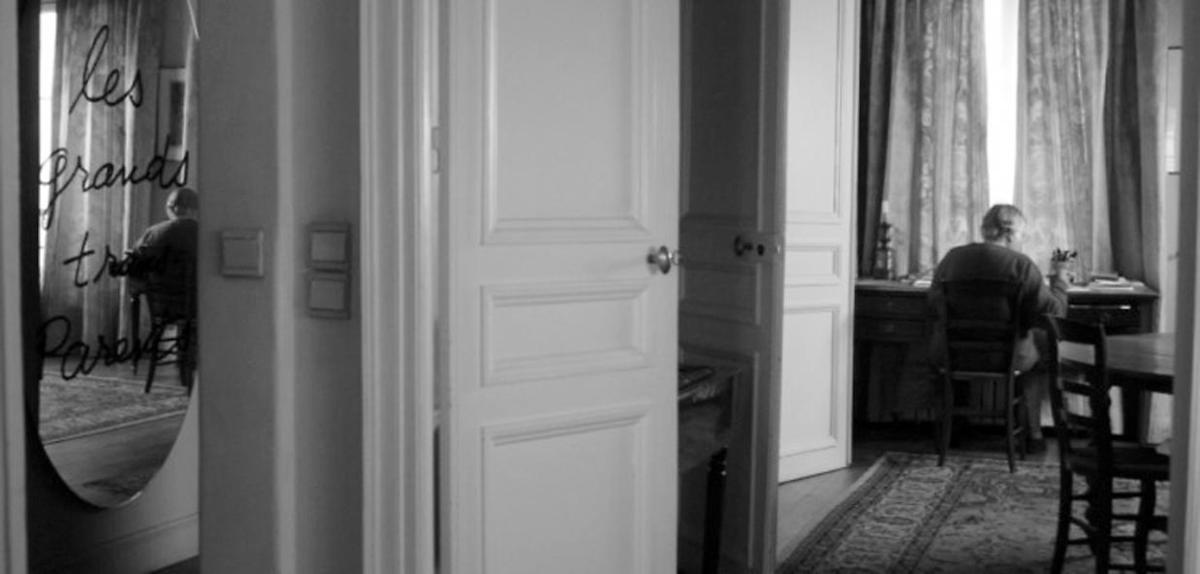
“2012 is the year of Etel Adnan,” declared Hans Ulrich Obrist at Art Dubai this past March. She is “one of the great visionaries of our time,” he enthused, adding — in case anyone might accuse him of underselling the French-Lebanese artist — “The twenty-first century is an Adnan century.” At Documenta (13) she’s everywhere: premiering Motion (2012), a Super-8 collage feature; author of The Cost For Love We Are Not Willing To Pay in the exhibition’s 100 Notes — 100 Thoughts publication series; talking about the new German translation of her book-length poem Arab Apocalypse (1989).
Perhaps the most intriguing example of contemporary Adnania is I See Infinite Distance Between Any Point And Another (2012), a 33-minute film by the Otolith Group (Kodwo Eshun and Anjalika Sagar) in which the poet — occasionally punctuated by archival images of nature photography from the 1920s and 1930s, and bookended by a quite remarkable aerial shot of ice floating across the River Danube — reads aloud from her poem “Sea” (from Sea And Fog, also 2012) while sitting at a table in her Paris apartment.
One might naturally fear for a film that can be described as a half-hour-long poetry reading. But what transpires during I See Infinite Distance bears little relation to the happenings at dust-dry evenings in local bookstores, watching authors stutter through recitations of their work. The film shoots the poet mostly from behind the shoulder, such that the nape of her neck and her liver-spotted hands are more visible than her face; it also deploys meticulously recorded ambient noise, which makes the space of the room as nearly palpable a presence as the maritime landscapes invoked by the verse. For all the film’s exquisite framings and chromatisms, it’s tempting to think of it more as a sonic artifact than a visual one.
Tempting, but wrong. Eshun, who had invited Adnan to read her 2004 poem “Jenin” during an Otolith Group show at Bétonsalon, Paris in 2011, recalls being struck “by the difficulty she had reading it. I realized it wasn’t poetry to be intoned or read out loud. When I read Sea and Fog, it was just astonishingly discontinuous. To me that implied something very cinematic: she jump cuts from one sentence to another and then within the sentence. Sea and Fog is just full of astonishing non-images, images which have no visual correlative at all, purely syntactical images.” As Sagar says, “Etel for me is a mystic as well as a poet. She uses a meta-language which has the ability to restructure time and memory. She does this by casting spells.” The empiricist crowd may decry that kind of language, but the wonder of the Otolith Group’s film lies in its successful positing of Adnan as a strange force field, an eldritch signifying system, whose messages compel because, rather than in spite of, their opacity.
For Eshun, the appeal of “Sea” lay in its difficulty: “It’s a harrowing experience, not easy at all. It exists on a continuum between poetry, philosophy, and prose — like some of Michel Serres’ texts. There’s an untethering of words from the common ground that they’re stabilized by; they just take off from the ground and float off. Nothing keeps the words together except the structure and your determination.”
I See Infinite Distance is the second film in the Otolith Group’s “hydropolitics trilogy,” in which water is used as a conceptual tool to think about history, memory, and globalization. The first, Hydra Decapita (2010), looked to the sonic fictions of Detroit electronica act Drexciya to explore the intersection between Middle Passage slavery and contemporary finance capitalism. The third, called The Radiant (2012), takes as its starting point last year’s Japanese tsunami and the partial meltdown of the Fukushima Daiichi nuclear power plant. Adnan’s poem “Sea” broaches themes that arise throughout. “Etel uses ideas from science and from philosophy that deal with the turbulence of water, the elusiveness and instability of water, its dangers, the difficulty of capturing it at the level of language or the image.”
Constriction is the film’s weapon, its gamble and its affront. The porousness and expansiveness of Adnan’s poetry are deferred — but also intensified — by constricting not just space, but volume too. “What is Etel whispering? What is she saying? As soon as you ask that we’ve got you,” Eshun says.
If the Otolith Group’s interest in the auditory aspects of Adnan’s work makes sense (they take their name from a part of the inner ear), so, as artists drawn to speculative fiction, does their fascination in its more non-terrestrial dimensions. Much of Adnan’s writing is published by Post-Apollo Press (think: space flight) and is studded with cosmic or UFO-logical metaphors. It might be said to express a weariness with the gravity of history, as well. Certainly I See Infinite Distance can be seen as a collaborative film that complicates any reading of Adnan that prizes her exclusively for her concern with Lebanon and the political traumas of war.
“Inverted astronomy. Opening up the perspective from earth to moon, and moon to earth: Etel’s very interested in that,” notes Eshun. “She thinks the calendar should be named after Neil Armstrong, that the calendar should have begun again after the moon landing. She believes that artists still need to grapple with the profound dimensions of space that were opened up after that. She’s interested in art that is astronomical, de-anthropological, de-anthropomorphising. An art that decenters the human. I sympathize with that very much.”